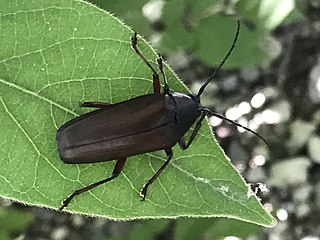Related Research Articles

The longhorn beetles (Cerambycidae), also known as long-horned or longicorns, are a large family of beetles, with over 35,000 species described. Most species are characterized by extremely long antennae, which are often as long as or longer than the beetle's body. In various members of the family, however, the antennae are quite short and such species can be difficult to distinguish from related beetle families such as the Chrysomelidae. The scientific name of this beetle family goes back to a figure from Greek mythology: after an argument with nymphs, the shepherd Cerambus was transformed into a large beetle with horns.

The Chrysomeloidea are an enormous superfamily of beetles, with tens of thousands of species. The largest families are Cerambycidae, long-horned beetles, with more than 35,000 species, and Chrysomelidae, leaf beetles, with more than 13,000 species.
Francis Polkinghorne Pascoe was an English entomologist mainly interested in beetles.

Chahuis or xamoes are the common names given in Mexico to a variety of edible insects within the insect order Coleoptera. The insects' common names in English are often sticks worms, rhinoceros beetle, or just grub.

Lamiinae, commonly called flat-faced longhorns, are a subfamily of the longhorn beetle family (Cerambycidae). The subfamily includes over 750 genera, rivaled in diversity within the family only by the subfamily Cerambycinae.

The Disteniidae are a small family of beetles in the superfamily Chrysomeloidea, traditionally treated as a group within the Cerambycidae.

The Oxypeltidae are a small family belonging to the superfamily Chrysomeloidea, widespread in the Andean region of Chile and Argentina. They have traditionally been considered a group within the Cerambycidae.

Lepturinae, the lepturine beetles, is a subfamily of the longhorn beetle family (Cerambycidae), containing about 150 genera worldwide. This lineage is most diverse in the Northern Hemisphere. Until recently the subfamily Necydalinae was included within the lepturines, but this has been recently recognized as a separate subfamily. Nine tribes are usually recognized today, with a tenth, Caraphiini, created in 2016. A few genera are of uncertain placement within the subfamily.
Argyrodines is a genus of beetles in the family Cerambycidae, containing the following species:

Trachyderini is a tribe of long-horned beetles in the family Cerambycidae. There are at least 140 genera and 650 described species in Trachyderini.
Cosmisoma humerale is a species of beetle in the family Cerambycidae. It was described by Bates in 1870.
Cosmisoma tibiale is a species of beetle in the family Cerambycidae. It was described by Per Olof Christopher Aurivillius in 1920.
Lepturgantes is a genus of beetles in the family Cerambycidae, containing the following species:
Closteropus blandus is a species of beetle in the family Cerambycidae. It was described by Félix Édouard Guérin-Méneville in 1844.
Dihammaphora lineigera' is a species of beetle in the family Cerambycidae. It was described by Chevrolat in 1859.
Dmytro Zajciw was a Ukrainian and Brazilian entomologist, notable for his collection and for his many beetle discoveries. He was born in Velyka Mykhailivka, Ukraine and died in Rio de Janeiro, Brazil. He was the author of Two new genera and species of neotropical Longhorn beetles , 1957, Contribution to the study of Longhorn beetles of Rio de Janeiro , 1958, and was the first to describe the genera Adesmoides and Pseudogrammopsis, as well as the species Beraba angusticollis and Mionochroma subaurosum, among many others.
Estola albovaria is a species of beetle in the family Cerambycidae. It was described by Stephan von Breuning in 1940. It is known from French Guiana.
Estola cayennensis is a species of beetle in the family Cerambycidae. It was described by Stephan von Breuning in 1940. It is known from French Guiana.
Estola columbiana is a species of beetle in the family Cerambycidae. It was described by Stephan von Breuning in 1940. It is known from Colombia, from which its species epithet is derived.

Sphenostethus taslei is a species of beetle in the family Cerambycidae. It is found throughout the eastern United States, from Pennsylvania to Texas. Craighead noted that its larvae are unusual in their habit of boring into dry dead treetop limbs, rather than damp wood near the ground This point was contested by Vlasak & Vlasakova, who recorded that S. taslei larvae were more frequently found in fallen limbs, not necessarily preferring treetop branches. They also argued against the association with dry branches, finding instead a larval preference for limbs of smaller diameter compared to other prionids. Various hardwoods are used as larval hosts, including oak, chestnut, and redbud. They are also frequently found in American beech. Craighead remarked that the adults of this species are rarely seen, but the larvae are quite common.
References
- ↑ Bezark, Larry G. A Photographic Catalog of the Cerambycidae of the World Archived 2013-08-27 at the Wayback Machine . Retrieved on 22 May 2012.